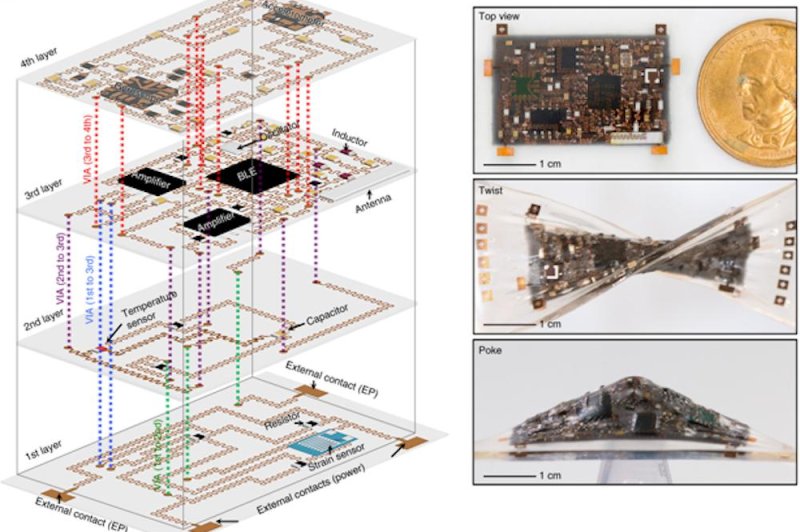Researchers created a unique, multifunctional electronic bandage by stacking flexible layers of circuits. Photo by Zhenlong Huang, et al./Nature Electronics
Aug. 13 (UPI) -- Scientists at the University of California, San Diego have built a stretchable electronic patch capable of measuring a variety of biological activities, including respiration, temperature and eye movement, as well as heart and brain activity.
Researchers have previously demonstrated the advantages of creating complex electronics by stacking rigid circuits. As part of the latest proof of concept study, scientists stacked flexible circuits. The method allowed researchers to achieve more sophisticated functionality while maintaining flexibility.
"Our vision is to make 3D stretchable electronics that are as multifunctional and high-performing as today's rigid electronics," Sheng Xu, a professor of nanoengineering at the UCSD Center for Wearable Sensors, said in a news release.
The newly designed patch features four circuitry layers, each layer features an electronic component embedded in a silicone elastomer substrate. Together the integrated layers form what's called an "island-bridge" design.
The electronic components represent the islands, while spring-shaped copper wires form the bridges between each of the layers.
"The problem isn't stacking the layers," said Xu. "It's creating electrical connections between them so they can communicate with each other."
In rigid electronics, connections between layers are formed by conductive holes called vertical interconnect accesses, or VIAs. The conductive holes are created through a combination of lithography and etching, but the same technology doesn't work when using stretchable elastomers.
To build connections between the stretchable layers, scientists created holes with lasers and filled them in with conductive materials.
The technology allowed scientists to combine a variety of electronic functions into a small, flexible package.
"We didn't have a specific end use for all these functions combined together, but the point is that we can integrate all these different sensing capabilities on the same small bandage," said researcher Zhenlong Huang, a Ph.D. student in Xu's lab.
Researchers described their electronic bandage in the journal Nature Electronics.















